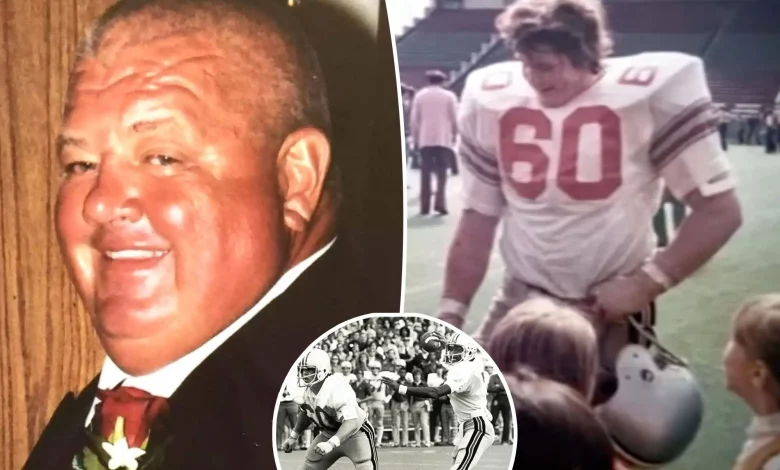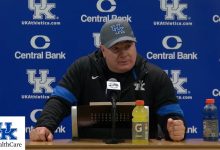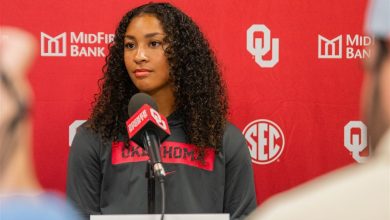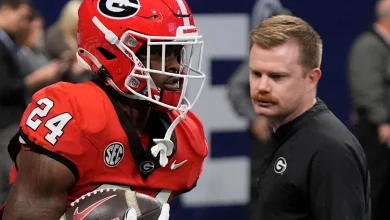Ted Smith held down the starting left guard position for Ohio State during both of Archie Griffin’s Heisman Trophy-winning campaigns, playing a pivotal role in the Buckeyes’ dominant ground game.

In the rich and storied history of Ohio State football, certain names echo through the decades—legends whose feats are immortalized in statues, awards, and chants inside Ohio Stadium. But behind every superstar, there are pillars—linemen in the trenches, often nameless to the masses, yet indispensable to the dynasty. Ted Smith, the Buckeyes’ stalwart starting left guard during both of Archie Griffin’s Heisman Trophy-winning seasons, is one of those pillars. And his story deserves the spotlight.
From 1973 to 1975, Smith was a fixture on an Ohio State offensive line that defined physicality, execution, and unselfish dominance. A native of Alliance, Ohio, Smith arrived in Columbus as a quietly confident interior lineman with a reputation for grit and discipline. By his sophomore year, he had locked down the starting left guard position—a role he would never relinquish. Week after week, he faced the nation’s best defensive linemen and delivered punishing blocks that cleared the way for history.
And it was Smith, along with fellow linemen like Kurt Schumacher and Steve Myers, who created the lanes that helped Archie Griffin run his way into immortality.
“There is no Heisman without that offensive line,” Griffin has often said. “And Ted Smith was right there—reliable, strong, always doing his job. He made my job easier.”
Indeed, Griffin’s back-to-back Heisman campaigns in 1974 and 1975 were as much a tribute to Ohio State’s offensive infrastructure as to his own breathtaking skill. With Smith paving the way on the left side, the Buckeyes became a steamroller on the ground, overwhelming opponents with a relentless rushing attack built on precision and toughness.
In 1974, Griffin rushed for 1,695 yards and 12 touchdowns. In 1975, he added 1,450 yards and another four scores—numbers that don’t fully capture his impact, but owe much to the consistent, selfless work of linemen like Smith. Every cut, every second-level burst, was made possible by the initial push—and Smith, with his low pad level and flawless technique, was often the first point of contact.
“Ted wasn’t the loudest guy,” said former OSU assistant coach George Hill. “But you couldn’t get him out of position. He was like a wall. Fast hands, great footwork, just relentless.”
The Buckeyes of that era were national contenders every year, known for their physical dominance and machine-like consistency. Under the legendary Woody Hayes, the offense revolved around “three yards and a cloud of dust”—a philosophy that demanded linemen be smarter, tougher, and more precise than their opponents. Ted Smith thrived in that system.
“He fit Woody’s style perfectly,” said former teammate Brian Baschnagel. “Ted wasn’t interested in glory. He just wanted to win, and he knew that winning started up front.”
Smith’s contributions came not only in the form of crushing run blocks but in his leadership. As a veteran presence on the line, he mentored younger players, ensured cohesion in pass protection schemes, and rarely—if ever—made mental mistakes.
“We all trusted Ted,” said Archie Griffin. “When you lined up behind him, you knew the hole was going to be there.”
Perhaps most remarkable was Smith’s ability to perform in the biggest games. In 1975, against Michigan—a No. 4 vs. No. 1 showdown in Ann Arbor—Smith helped the Buckeyes control the line of scrimmage, opening lanes for Griffin and fullback Pete Johnson as Ohio State wore down the Wolverines in a bruising 21–14 victory. That win clinched a perfect regular season and sent the Buckeyes to the Rose Bowl for a shot at the national championship.
Though that game ended in a narrow loss to UCLA, Smith’s play throughout the season had already cemented his legacy as one of the most reliable guards in school history.
After graduating, Smith didn’t pursue NFL glory. Instead, he chose a quieter path—returning to Ohio, raising a family, and contributing to his community. But for those who remember that golden era of Ohio State football, his name carries enormous weight.
“There are a lot of All-Americans and award winners who come through here,” said one OSU historian. “But the guys who built the foundation—the ones who never took plays off, who showed up every Saturday and moved mountains so others could shine—those are the real legends. Ted Smith is one of them.”
In recent years, the university has made efforts to honor players from that iconic 1970s stretch, and Smith has remained a beloved figure at reunions, alumni events, and tailgates. Still modest and understated, he prefers to speak about the team rather than himself. But former players, coaches, and fans don’t let him disappear into the background.
“You talk to anyone who played in that era,” Griffin said, “and they’ll tell you: Ted Smith was the heart of that offensive line.”
In 2025, as Ohio State looks to both celebrate its past and shape its future, Smith’s legacy takes on renewed meaning. He represents a brand of football that still defines the Buckeyes—physical, disciplined, team-first. And in an age of highlight reels and headlines, his career reminds us that greatness is often built in the unseen spaces: in the film room, in the trenches, and in the spaces between whistles.
Now, nearly 50 years since his final collegiate snap, Ted Smith’s contributions endure—in the record books, in the stories told by his teammates, and in the championship standard that Ohio State still chases every season.
Because while quarterbacks win awards and running backs steal the spotlight, the soul of a team is often forged in the fire of the offensive line. And few embodied that soul better than the man at left guard, No. 64, from Alliance, Ohio.









